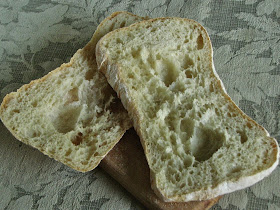Sometimes all I want is a good sandwich. Versatile and delicious, I could probably eat a sandwich every day. And we all know (I hope) that a good sandwich demands excellent bread. Sub-par, stale grocery store bread just doesn't do it for me anymore. I need something better. For me, that means I have two options; head to the bakery (which, trust me, I do a lot!) or make some of my own. One of these options is more convenient and, let's be honest, probably better, but the other option is super cheap, absolutely delicious, and extremely satisfying. Pulling warm loaves of homemade bread out of my oven only 4 ingredients later is one of my favorite ways to spend an afternoon. I highly recommend it!
This recipe is easy, and simple, although it does take some advanced planning and to be honest, some practice (at least for me). It turned out 3 beautiful loaves of ciabatta that were perfect for my sandwich craving.
Ciabatta
From The Bread Baker's Apprentice by Peter Reinhart
Ingredients
Poolish
- 2 1/2 cups (11.25 ounces) bread flour
- 1 1/2 cups (12 ounces) water, at room temperature
- 1/4 teaspoon instant yeast
Dough
- 3 1/4 cups (22.75 ounces) poolish
- 3 cups (13 1/2 ounces) unbleached bread flour
- 1 3/4 teaspoon salt
- 1 1/2 teaspoon instant yeast
- 6 tablespoons to 3/4 cup (3 to 6 ounces) water, lukewarm
Directions
For the Poolish: stir together the flour, water and yeast until all the flour is moistened. It will be soft and sticky, like very thick pancake batter. Cover the bowl with plastic and let sit at room temperature for 3 to 4 hours, until bubbly and foamy, then place in the refrigerator where it will keep for up to 3 days.
For the ciabatta: remove the poolish from the refrigerator 1 hour before starting. Stir together flour, salt and yeast in the bowl of a stand mixer fitter with the paddle attachment. Add the poolish and 6 tablespoons of the water and mix on low speed until the ingredients form a sticky ball, adding additional water as needed. Increase the speed to medium and mix for 5 to 7 minutes or until the dough is smooth and sticky. Switch to the dough hook and mix for 2 more minutes. The dough should clear the sides of the bowl but still stick to the bottom. You may need to add additional flour, but don't add too much, the final dough should be quite soft and sticky.
Spray about an 8-inch square part of your counter with cooking spray. Using a dough scraper, transfer the dough to the counter. Dust the top of the dough liberally with flour, patting it into a rectangle. Wait 2 minutes for the dough to relax. Coat your hands with flour, lift the dough from each end, stretching it to twice its size. Fold the dough over onto itself, like folding a letter, returning it to its originally shape. Dust the top of the dough with flour, and loosely cover with oiled plastic wrap.
Let rest for 30 minutes. The repeat the stretch and fold as above. Dust with flour and cover with plastic again. Let the dough ferment and rise on the counter for 1 1/2 to 2 hours. It should swell, but won't necessarily double in size.
Set up a couch with a cotton dish towel, sprayed with oil and generously floured. Carefully remove the plastic wrap from the dough. Using a pastry scraper, divide the dough into 3 rectangles, making sure not to degas the dough. Sprinkle the dough generously with flour and use the scraper to gently lift each piece from the counter and lay it on the floured cloth, folding each piece of dough from left to rich, letter-style, into an oblong about 6 inches long. Bunch the cloth between the pieces to provide a wall.
Proof for 45 to 60 minutes at room temperature, or until the dough has noticeably swelled. Meanwhile, place a baking stone in the oven and preheat to 500 degrees, placing an old heavy duty sheet on the lower rack.
When the dough is ready, gently transfer each piece of dough to a 9x12-inch piece of parchment paper, lifting from each end and gently tugging the dough out to just smaller than the piece of parchment. Slide the dough, parchment and all, onto the preheated baking stone. Pour one cup of hot water into the sheet pan and close the door. After 30 seconds, open the door and spray the sides of the oven with water from a spray can. Repeat twice more at 30 second intervals. After the last spray, turn the oven temperature down to 450 degrees and bake for 10 minutes. Rotate the loaves 180 degrees and continue baking for 5-10 minutes, or until done, the bread should register 205 degrees in the center and be golden brown. Allow loaves to cool at least 45 minutes before slicing and serving.






No comments:
Post a Comment